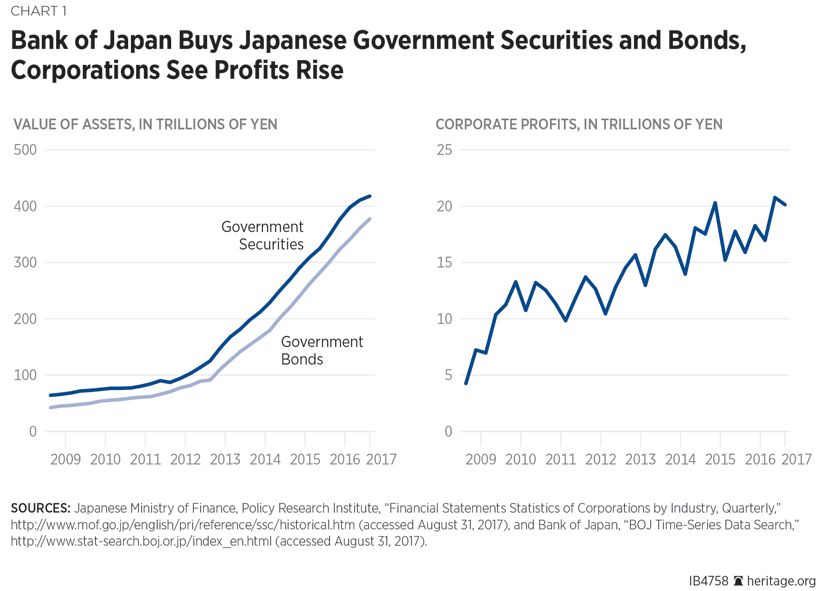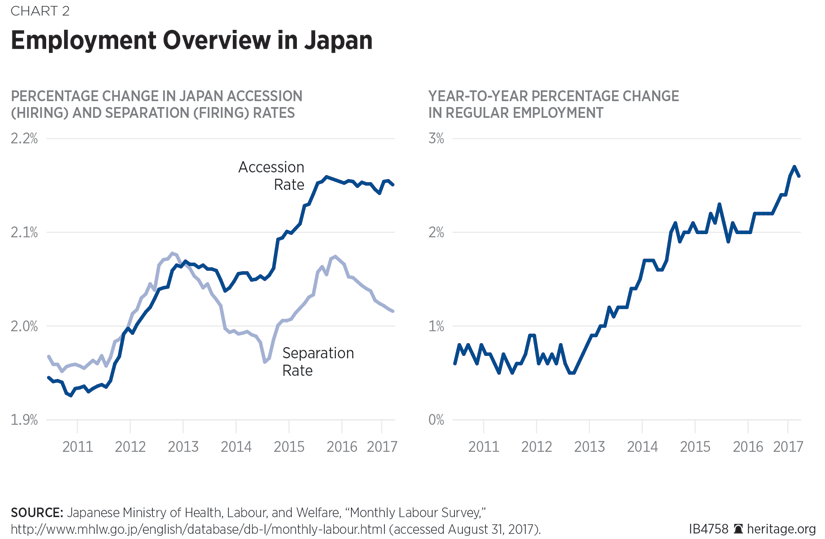This fall, Vice President Pence will continue the U.S.–Japan Economic Dialogue—established in February 2017—with Deputy Minister Taro Aso. A central issue for discussion is how monetary and fiscal policies mutually reinforce structural policies. While both leaders are keen to increase investment and trade opportunities, current U.S. and Japanese monetary policies are not aligned. Japanese monetary policies incentivize malinvestment, which leads to inefficiency and lackluster growth in the long run.
The Trump Administration should seek cooperation in areas that can increase opportunities for growth for both countries, and encourage Japan’s continued structural reforms, while remaining aware that Japan’s monetary policies have not put Japan’s economy on a sustainable path to growth.
Japan’s Misguided Monetary Policy
Japan's central bank, the Bank of Japan (BOJ), has distorted Japanese markets by creating an artificial increase in the demand for labor as corporate profits hit an all-time high. Since April 2013, the BOJ has purchased between 60 trillion and 80 trillion yen annually in Japanese government bonds (JGB)—making the BOJ the largest holder of JGBs at around 40 percent.[REF] The BOJ is also now the majority owner in exchange-traded funds market with over 60 percent of shares.[REF] The value of government securities owned by the BOJ total 427 trillion yen (80 percent of gross domestic profit)—the highest of any central bank. The creation of this artificial increase in demand for labor is extremely problematic, as this equates to inefficiency. Given decreasing and ageing population, Japan cannot risk inefficiency in employment if it is to effectively prepare for the future.

The BOJ’s purchases are central to Bank Governor Haruhiko Kuroda’s four-year effort to achieve a stable 2 percent growth in consumer prices. BOJ officials argue that growth in consumer prices—which has been considerably less than 2 percent in the past—encourages more production, which in turn encourages more consumption, thus propagating a virtuous cycle of growth.[REF]
Despite inflation remaining under 2 percent, Kuroda’s strategy has worked in some circles. The BOJ’s monetary policy has contributed to a boom in the stock market. The face value of Japan’s stock market has increased roughly 70 percent over this period, with stocks hovering around a 15-year high. Japanese corporate profits totaled 20.1 trillion yen in the first quarter of 2017.[REF] Profits will likely continue to increase as a result of Prime Minister Shinzo Abe’s reduction of Japan’s corporate tax rate from 37 percent to 30 percent last year.[REF]
Japan’s Labor Outlook Is Poor
As Japanese corporations expand in correlation with increased profits, so has the demand for labor. Japan’s unemployment rate continues to decrease and is now one of the lowest in the world at 2.8 percent.[REF] Demand for labor is so high that for every job applicant, there are 2.1 new job openings. That number is increasing.[REF] Japan’s growth in labor has seen increased employment in the sectors of health care, retail, services, and construction.[REF]
Taken alone, however, this expansion of demand for labor is misleading. Increased demand for labor is normally accompanied by an increase in wages as companies seek to offer employment to the highest skilled. And, increased wages lead to greater disposable income for consumers, which in turn leads to production and consumption. Such is not the case in Japan.
The theory behind wage growth only works if employees are willing to leave their current job for a higher paying job. Japan’s job turnover rate, remains at roughly 2 percent. The U.S. turnover rate is roughly 3.5 percent. Low job turnover occurs as cultural and institutional barriers in Japan continue to restrict the movement, and firing, of employees from their current jobs. Thus, although corporations are making more money and more people are working, Japan is not creating meaningful jobs in a sustainable way.

Japan’s decreasing and aging population make the need for efficient employment even more necessary—although the determination of where jobs are needed most is difficult. By 2050, one in three Japanese will be over the age of 65. This demographic state will stretch entitlement programs and increase demand for eldercare. In addition, more parents working means fewer stay-at-home parents, increasing the demand for labor in childcare programs. The increase in part-time hires may allow for greater job turnover, but also contributes less to wage growth. Corporations will continue to hire and retain regular employees longer than may be necessary.
Guidance for Policy Decisions
The economic dialogue between the U.S. and Japan should examine the underlying macroeconomic factors that affect how and when policy decisions are made as they focus on trade, investment, and other areas for cooperation.
- Discuss Central Bank leadership and policy. The next U.S.–Japan Economic Dialogue will occur before the Governors for both the Federal Reserve and Bank of Japan (possibly) change in February 2018. The U.S. and Japan should take this time to highlight the distorting effects of Japan’s monetary policies on the future of Japan’s economy and the U.S.–Japan economic relationship. The future of U.S. and Japanese monetary policies should be of greater concern for this upcoming U.S.–Japan Economic Dialogue than it was in the previous dialogue.
- Determine an exit strategy. Japan’s current monetary policies are ineffective. Continuing with more quantitative easing, or yield targeting, will do nothing to change that. The BOJ should consider an exit, regardless of political risk. The effort mostly falls on the shoulders of the BOJ as there is little the Japanese government can do to change the autonomous policies of its central bank. The U.S. government has even less influence.
- Pursue opportunities for trade and investment. Japan should continue seeking new opportunities for growth. Increased U.S.–Japan economic cooperation—including a bilateral agreement with the U.S.—is one option. Japan has other options with the Regional Comprehensive Economic Partnership (RCEP—centered around the Association of Southeast Asian Nations), the China–Japan–South Korea free trade agreement negotiations, bilateral agreements with other countries, and a continued Trans-Pacific Partnership.
Over the next generation, Japan will have to balance caring for an older population with maintaining a level of growth that offsets debts. Current monetary policies are more likely to put Japan on an unsustainable path to growth. The U.S. should make encouraging Japan’s continued structural reforms central to the U.S.–Japan Economic Dialogue.
—Riley Walters is a Research Associate in the Asian Studies Center, of the Kathryn and Shelby Cullom Davis Institute for National Security and Foreign Policy, at The Heritage Foundation.


